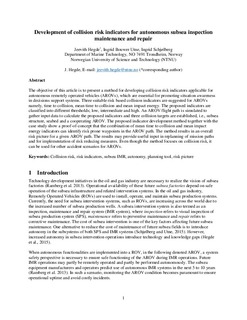| dc.contributor.author | Hegde, Jeevith | |
| dc.contributor.author | Utne, Ingrid Bouwer | |
| dc.contributor.author | Schjølberg, Ingrid | |
| dc.date.accessioned | 2017-11-07T12:47:27Z | |
| dc.date.available | 2017-11-07T12:47:27Z | |
| dc.date.created | 2016-12-05T15:45:30Z | |
| dc.date.issued | 2016 | |
| dc.identifier.citation | Journal of Loss Prevention in the Process Industries. 2016, (44), 440-452. | nb_NO |
| dc.identifier.issn | 0950-4230 | |
| dc.identifier.uri | http://hdl.handle.net/11250/2464655 | |
| dc.description.abstract | The objective of this article is to present a method for developing collision risk indicators applicable for autonomous remotely operated vehicles (AROVs), which are essential for promoting situation awareness in decisions support systems. Three suitable risk based collision indicators are suggested for AROVs namely, time to collision, mean time to collision and mean impact energy. The proposed indicators are classified into different thresholds; low, intermediate and high. An AROV flight path is simulated to gather input data to calculate the proposed indicators and three collision targets are established, i.e., subsea structure, seabed and a cooperating AROV. The proposed indicator development method together with the case study show a proof-of-concept that the combination of mean time to collision and mean impact energy indicators can identify risk prone waypoints in the AROV path. The method results in an overall risk picture for a given AROV path. The results may provide useful input in replanning of mission paths and for implementation of risk reducing measures. Even though the method focuses on collision risk, it can be used for other accident scenarios for AROVs. | nb_NO |
| dc.language.iso | eng | nb_NO |
| dc.publisher | Elsevier | nb_NO |
| dc.rights | Attribution-NonCommercial-NoDerivatives 4.0 Internasjonal | * |
| dc.rights.uri | http://creativecommons.org/licenses/by-nc-nd/4.0/deed.no | * |
| dc.title | Development of collision risk indicators for autonomous subsea inspection maintenance and repair | nb_NO |
| dc.type | Journal article | nb_NO |
| dc.type | Peer reviewed | nb_NO |
| dc.description.version | acceptedVersion | nb_NO |
| dc.source.pagenumber | 440-452 | nb_NO |
| dc.source.journal | Journal of Loss Prevention in the Process Industries | nb_NO |
| dc.source.issue | 44 | nb_NO |
| dc.identifier.doi | 10.1016/j.jlp.2016.11.002 | |
| dc.identifier.cristin | 1408552 | |
| dc.relation.project | Norges forskningsråd: 223254 | nb_NO |
| dc.relation.project | Norges forskningsråd: 234108 | nb_NO |
| dc.description.localcode | © 2016. This is the authors’ accepted and refereed manuscript to the article. LOCKED until 8.11.2018 due to copyright restrictions. This manuscript version is made available under the CC-BY-NC-ND 4.0 license http://creativecommons.org/licenses/by-nc-nd/4.0/ | nb_NO |
| cristin.unitcode | 194,64,20,0 | |
| cristin.unitname | Institutt for marin teknikk | |
| cristin.ispublished | true | |
| cristin.fulltext | original | |
| cristin.qualitycode | 1 | |

